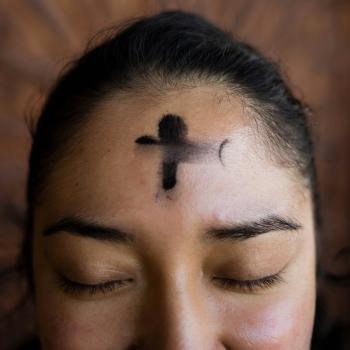In all these Marian feasts that are a part of the Catholic faith I’ve embraced, I’ve participated with a kind of curious fascination during the past couple of years, trying to get my mind around it all – and often finding that in the end the most I could do was, like Mary herself, to keep all these things and ponder them in my heart.
Marian doctrine was never really a make-or-break issue for me, but I had a few of the typical questions, and to some extent still do. Any hesitation on the “Mother of God” title was easy enough to get over once I understood what it really means (and a basic acquaintance with its history confirmed an earlier realization that it is a Christological statement more than anything). My more difficult question on the immaculate conception was given articulation by something I saw on EWTN, of all things. Someone was explaining an icon of the baptism of the Lord, pointing out Jesus’ total submersion in the dark water, surrounded by eerie-looking skeletal fish, to symbolize his total descent into the depths of human sin and suffering. If the sinless Christ could descend so thoroughly into the midst of our ugliness, I wondered, couldn’t he have deigned to be born to an ordinary sin-prone person?
This question was never really resolved in my mind, just overshadowed by bigger things that made it worth setting this one aside and trusting the Church on the matter. But today, somewhere in the middle of the homily in an otherwise unremarkable Mass in an unfamiliar parish, something clicked. Maybe it was the celebrant’s reference to the Greek title “God-bearer”, in connection with the dynamic meaning of shalom as more than just the absence of conflict but as the fullness of well-being that was present at the creation of humanity, as yet unconstrained by the allure of something less than what we were made for. Was that Mary’s freedom – the freedom to embody the full shalom that we were all made to live?
Mary’s fiat, Nathan O’Halloran reflected earlier, is “a pure speech, a speech untouched by the serpent that is inside of each one of us.” Perhaps this is why her assent was truly free in the fullest sense – free from the demons of fear and self-interest that often constrain us from seeing and accepting what is most truly good, free to say “yes” to so great a mystery. In short, she said yes because she got it.
I don’t know whether the Incarnation had to happen this way – whether it’s the only way it could have happened. On this we can only speculate. But I’m beginning to think that maybe it’s the best way it could have happened. At the least, the radical grace manifested in the freedom of the God-bearer surely resonates as a piece of the Great Story – the redemption story so profoundly beautiful that it just has to be true.












